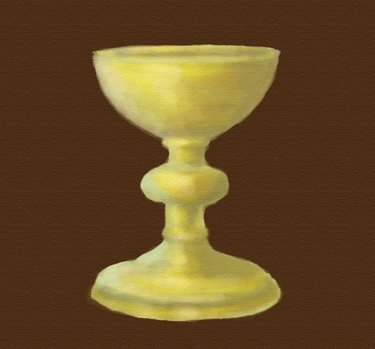
Shading is important to creating paintings that have a realistic and natural look to them. Without shading, paintings can look flat and dull. Shading allows light to play off of the objects, scenery and people in your paintings and brings these images to life with vivid detail. The basics of shading are quite simple, however the numerous applications can take years to truly master.
Creating the Foundation.
Video of the Day

Lay out your basic colors first, including a background color. It's important to use a rich natural color for the background as this will allow you to create shading on your painting that is more realistic in nature than if you had a plain white background. It is not often that people find themselves looking at any scene, person or object that sports a stark white background. Even something as basic as plain brown will allow the rest of your painting to have a rich depth of shadows and highlights.
Video of the Day
Paint on the the base colors in your painting. Choose the simplest mid-range color that could be seen as an "average" of the total colors in your painting. A great way to figure this out is to look at the object, scene or person that you are painting and squint your eyes. This will help you choose the best base colors for your paintings as squinting your eyes removes some of the detail from your vision. Paint out only the shape of the objects you are painting, do not try to add in details, highlights or shadows at this point.
Placing Highlights and Shadows

Consider your light source to create proper shading. Your light source is the direction from which light is shining within the world of your painting. It could be orange sunlight at dusk, spilling through an open window or the flickering flame of a small lantern or candle left on an old wooden table. It could even be the cold pale light of a full moon peeking from behind the trees.
Decide where the light is coming from and be sure to keep this consistent as this will allow you to place your highlights and shadows effectively. Highlights should be placed on the objects, appendages or scenery that are most directly exposed to the light source.
Place lighter and high quantities of highlights on the areas directly exposed to the light source. For example, if your light source is in the upper left hand corner and the object is a chalice or cup, the rim of the cup as well as the upper left side will catch a lot of light. Some highlights will appear on the left side of the stem of the chalice and the base of the item will also catch some light, particularly on the left side. A handy trick is to break up each object into several smaller object and consider how the light hits each section.
To create shadows simply reverse the logic of highlights. Apply shadows to the areas that are furthest away from the light or have been blocked from having light cast on that particular section.
Blending for Natural Shading

Blend the highlights and shadows into the the picture to achieve proper shading. Pull areas of highlights slightly into the areas of mid-tones with your brush. Smooth the shadow areas into the mid-tone regions as well. You can also blend some of the mid-tone hues into the highlight and shadow regions. Experiment on a smaller section of your painting until you can create a smooth and natural blending of colors and hues.
After you have blended the shading on your painting, you can go back in and add a tiny amount of extra highlight to the very brightest areas. Do this as well for the shadowed sections. It's important not to go overboard. Look at your real life reference and make sure that you are capturing the shading and color blends correctly.